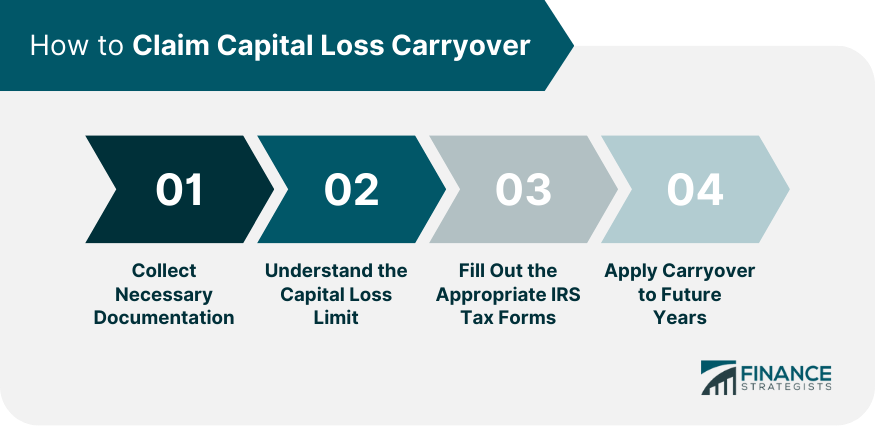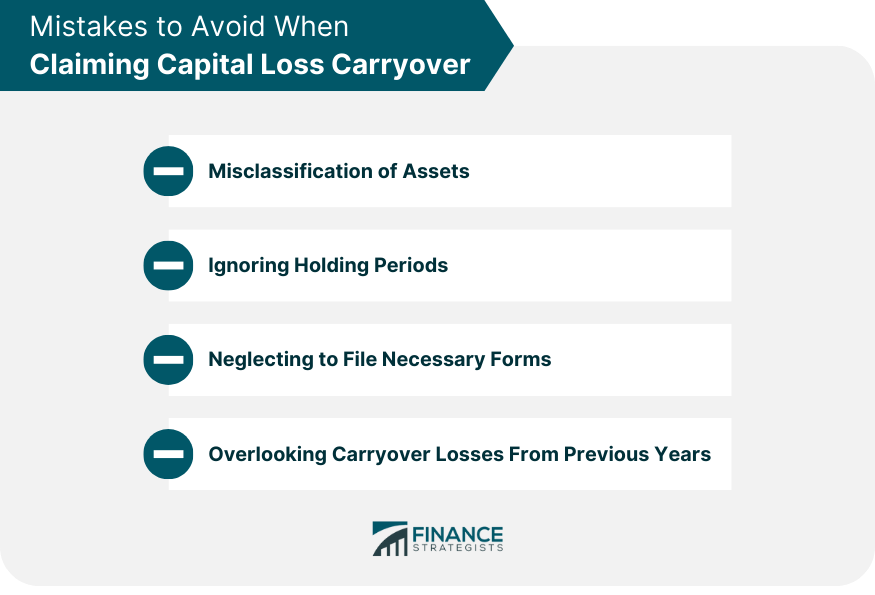Once you have determined your capital losses, claiming your capital loss carryover becomes the next step. The process involves several stages, each of which is crucial to ensuring the proper handling of your capital losses. Before you begin claiming your capital loss carryover, ensure you have all the necessary documentation. This includes your past tax returns and investment records. These documents will help you establish your cost basis for the sold assets, your holding period, and the amount you received from the sale. Understanding the capital loss limit set by the IRS is a significant stage in the process. As of 2023, this limit stands at $3,000 for individuals and $1,500 for those who are married and filing separately, or your total net loss shown on line 16 of Schedule D (Form 1040), whichever is less. However, it's not the end of the road if your losses exceed this threshold. The IRS allows these excess losses to be carried over to subsequent tax years. This provision serves as a relief mechanism, allowing you to distribute your losses over several years, reducing your tax burden over time. Claiming capital loss carryover involves filling out specific tax forms. These include Schedule D (Capital Gains and Losses) and Form 1040 (U.S. Individual Income Tax Return). Schedule D is where you calculate your overall capital loss or gain, including the capital loss carryover from previous years. The net capital loss calculated on Schedule D is then reported on Form 1040. Your journey with capital loss carryover doesn't end within a single tax year. If your capital losses outstrip the annual limit, the IRS allows you to carry the excess over to the following years. You can continue this process of carryover until the entire loss has been deducted. This ongoing application is a testament to the longevity of capital loss carryover. Hence, it's crucial to maintain a comprehensive record of these losses, as they hold the potential to significantly influence your tax situation in the future, providing relief by reducing your tax liability year after year. One of the most frequently encountered errors in claiming capital loss carryover is the misclassification of assets. It is fundamental to distinguish between capital and non-capital assets as only losses from capital assets are deductible. Misclassification can inadvertently lead to incorrect filings and missed opportunities for deductions. Thorough knowledge and accurate categorization of your assets are integral to reaping the full benefits of capital loss deductions. Another prevalent pitfall involves neglecting the role of holding periods in determining the nature of capital losses. The tax treatment of capital losses varies based on whether the loss is short-term (held for one year or less) or long-term (held for more than a year). Overlooking this can lead to miscalculations and missed deductions. By acknowledging the holding periods of your assets, you ensure accurate calculation of your losses, thereby optimizing your capital loss carryover. A vital part of claiming capital loss carryover is accurately completing the required tax forms. Schedule D and Form 1040 are pivotal in this process. Neglecting to file these forms or completing them inaccurately can jeopardize your claim. These forms serve as an official record of your capital gains and losses, making it crucial to fill them out accurately and in their entirety. Ensuring meticulous completion of these forms not only helps you avoid errors but also fosters a comprehensive understanding of your capital loss situation. Remember to account for carryover losses from previous years. These losses can continue to be carried over year after year until they're fully deducted. Capital loss carryover serves more than just a means to claim deductions; it's a pivotal tool in the arena of strategic tax planning. Employing it effectively can significantly impact your tax situation, optimizing your financial outcomes. Strategic tax planning revolves around the careful balancing of capital gains and losses. By understanding the interplay between these two elements, you can use it to your advantage to minimize your overall tax liability. Mastering this balance means understanding when to realize capital losses to offset gains, turning potential financial setbacks into strategic moves. Part of the art of strategic tax planning involves tactfully realizing capital losses. By strategic timing, when you sell off loss-incurring assets, you can offset your capital gains, leading to a reduction in your overall taxable income. This approach allows you to manage your financial landscape effectively, turning the unavoidable reality of capital losses into a strategic advantage in your tax planning journey. If your financial situation is complex or if you have significant amounts of capital gains or losses, it might be worthwhile to consult a tax professional. They can provide guidance and ensure you're complying with all relevant tax laws. Tax professionals have the knowledge and experience to handle complex tax situations. They can help you navigate the capital loss carryover process, ensure all relevant forms are completed correctly, and help you strategize your tax planning. Navigating the process of capital loss carryover entails understanding your capital losses, assembling relevant documentation, grasping the IRS's capital loss limit, and correctly filling out IRS forms. Errors such as misclassifying assets or neglecting to consider holding periods can derail this process. An overlooked aspect often is the strategic use of capital loss carryover for effective tax planning - balancing gains and losses to minimize tax liability. In complex cases or with sizable capital gains or losses, consulting a tax professional becomes invaluable. They provide expertise in handling intricate tax situations, ensuring correct form completion, and devising effective tax strategies. Understanding and correctly executing capital loss carryover is not merely about claiming deductions but also about strategic financial management and future tax planning.How to Claim Capital Loss Carryover
Collecting Necessary Documentation
Understanding the Capital Loss Limit
Filling Out the Appropriate IRS Tax Forms
Applying Carryover to Future Years

Mistakes to Avoid When Claiming Capital Loss Carryover
Misclassification of Assets
Ignoring Holding Periods
Neglecting to File Necessary Forms
Overlooking Carryover Losses From Previous Years

Strategic Application of Capital Loss Carryover
Balance of Capital Gains and Losses
Realizing Capital Losses to Offset Gains
Seeking Professional Help
When to Consult a Tax Professional
How Tax Professionals Can Assist With Capital Loss Carryover
Conclusion
How to Claim Capital Loss Carryover FAQs
A capital loss carryover occurs when your total capital losses in a year exceed the annual limit of $3,000 (or $1,500 if you're married and filing separately). The excess loss can be carried over to future tax years until it's completely deducted.
The classification depends on how long you've held the asset before selling it. If you've held the asset for one year or less before selling, it's considered a short-term loss. If it's more than one year, it's a long-term loss.
To claim a capital loss carryover, you'll need to fill out Schedule D (Capital Gains and Losses) of Form 1040 (U.S. Individual Income Tax Return). Schedule D is where you calculate your total capital loss or gain, including carryover losses from previous years.
Capital loss carryovers can be used strategically to offset your capital gains in future years. This can help reduce your taxable income, thereby minimizing your tax liability.
If you have a complex financial situation, significant amounts of capital gains or losses, or if you're unsure about how to properly file your tax forms, it might be beneficial to consult a tax professional. They can provide guidance, ensure compliance with tax laws, and help you strategically plan your taxes.
True Tamplin is a published author, public speaker, CEO of UpDigital, and founder of Finance Strategists.
True is a Certified Educator in Personal Finance (CEPF®), author of The Handy Financial Ratios Guide, a member of the Society for Advancing Business Editing and Writing, contributes to his financial education site, Finance Strategists, and has spoken to various financial communities such as the CFA Institute, as well as university students like his Alma mater, Biola University, where he received a bachelor of science in business and data analytics.
To learn more about True, visit his personal website or view his author profiles on Amazon, Nasdaq and Forbes.











